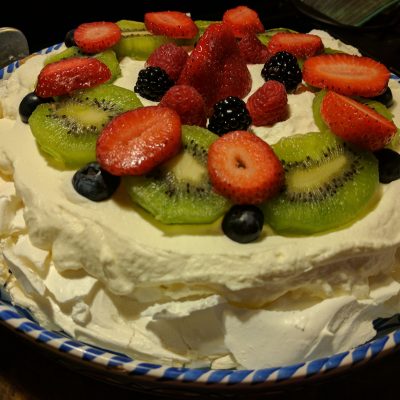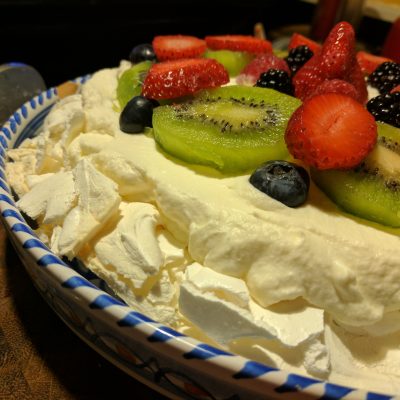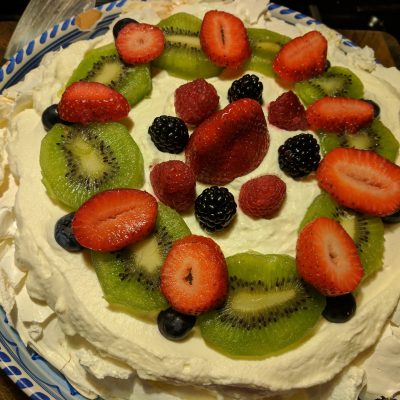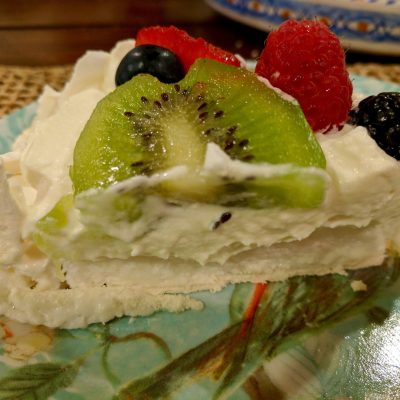




On Friday, geologists announced the discovery of a viable contender for an 8th continent: Zealandia. The landmass is almost entirely submerged by water, except for its highest mountains: New Zealand. What a coincidence it was that that very evening I planned to travel to New Zealand, not to celebrate the newly discovered potential continent, but to celebrate Holly’s 30th birthday with a lovely fruit pavlova.
This was my first attempt at pavlova, and I think I may have discovered one of my new favorite desserts. It’s a light dish, made from an airy meringue with a crunchy outer shell, topped with whipped cream and fresh fruit. There are dozens of varieties, but the most traditional is topped with berries and kiwi, a nod to New Zealanders. It’s a common Christmastime dessert, which is of course summer time in New Zealand. Light and cool, it’s really the perfect warm weather dessert, and I have two less traditional versions I’ll certainly be making for special occasions this summer.
The dessert was named after Russian ballerina Anna Pavlova following her 1926 tour of Australia and New Zealand. The two countries squabble over who created the recipe. As the New Zealand story goes, the chef of a Wellington hotel created the Pavlova in the dancer’s honor, claiming inspiration from her tutu. Meanwhile, Australians assert that the pavlova was invented at a hotel in Perth, named after the ballerina when one diner declared it to be “light as Pavlova.” Ultimately, perhaps neither can claim credit: recipes for similar meringue tortes outdating the Pavlova have been found in Germany and America. Still, they can certainly be credited with keeping the dessert wildly popular. The ballerina was a superstar of her day, and many chefs all around the world named dishes after her, this one just seems to be the one that has survived the test of time.
One more fun fact: students at the Eastern Institute of Technology in Hawke’s Bay, New Zealand created the largest pavlova in 2005: the “Pavkong” stretching 64 metres long.
|
1
Done
|
Preheat the oven to 250 degrees F. Line a baking sheet with parchment paper. Spray with non-stick cooking spray. |
|
2
Done
|
Using an electric mixer with the whisk attachment, beat the egg whites on medium-high speed until stiff peaks form. Add the granulated sugar and beat for 10 minutes. Wipe down the edges and beat. Rub between your fingers to make sure the sugar is dissolved. Add the cream of tartar and beat for one additional minute. |
|
3
Done
|
|
|
4
Done
|
Bake for 1 hour, or until firm to the touch. Turn off the oven and prop the oven door open. Allow to cool completely in the oven. If exposed to cold air too quickly, the shell will deflate. The shell can be made a day ahead and stored in the oven. |
|
5
Done
|
Once ready to serve, beat the cream on medium-high speed. When the cream begins to thicken, add the powdered sugar and vanilla extract. Continue to beat until soft peaks form, but no longer. |
|
6
Done
|
Spread cream in the center of the pavlova, leaving a ring of meringue still visible. Top decoratively with kiwi and berries. |